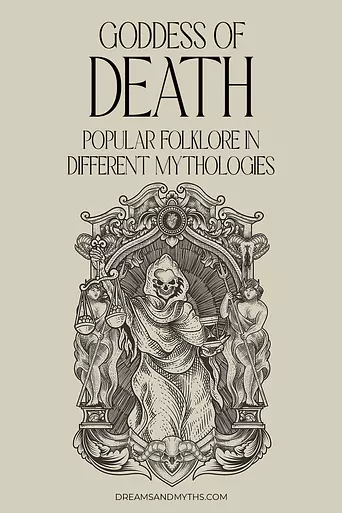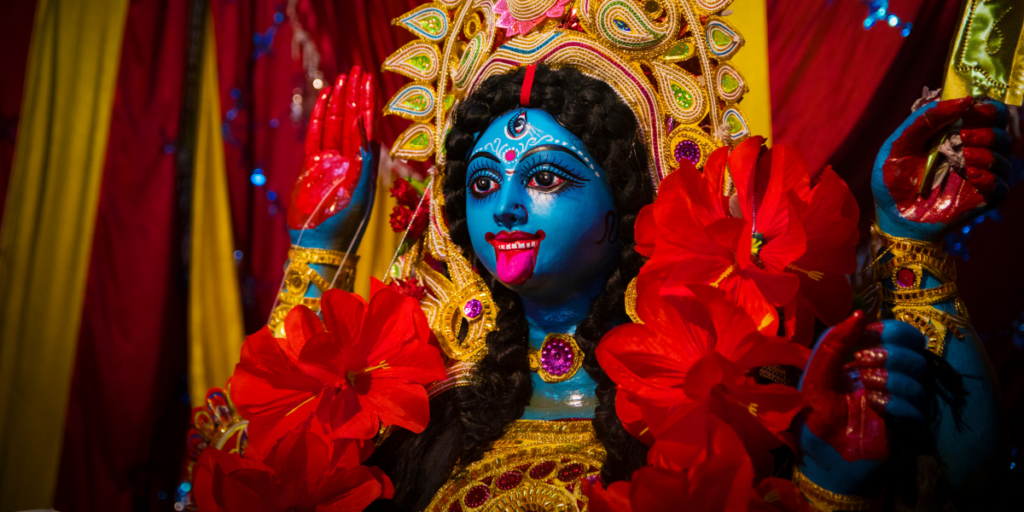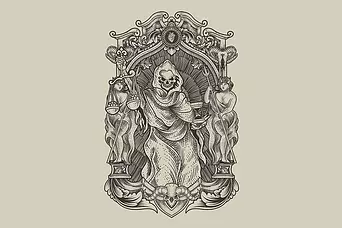Death in several mythologies is considered an integral part of the human life cycle. Mythologies around the world have different goddesses popularly representing death. We will explore some of the most captivating goddesses of death in different world mythologies and their popular folklores as well.

Death goddesses may not have worshippers who openly revere them, but they do have a cult following across different regions of the world.
Let’s dig deeper into this list of death goddesses.
Greek Mythology – Keres
The Keres were female death spirits, also referred to as the Goddesses, who were the personification of violent death.
They were the daughters of Nyx, the Goddess of night, and the sisters of Thanatos, the god of a peaceful death.
The Keres were beings who did not have the power to kill but were present during death or dying, and they would wait and feast on the souls of the dead.
They were dark beings with razor-sharp gnashing teeth and talons having a thirst for human blood. They would search and hover around battlefields where they could find the dying and dead. The moment any man who would get injured in a battle or was about to die would be caught by Keres with their clutches. Then the soul of the man would descend to the underworld to the domain of the god Hades who would next send them to the chilly depths of Tartarus.
Once the Keres had consumed the blood and soul of their victim, they would throw the body away and again begin the search for new prey.
Roman Mythology – Mors
In Roman mythology, Mors is considered to be the personification of death.
Although Ancient Roman art does not specify the gender of Mors, the ancient poets use the Latin noun of the word, which is of feminine gender.
The Roman poet Horace describes Mors as the Pale death, the one who kicks down the doors of the poorest of peasants and the richest of kings, not making any distinction between the classes of people. From here is derived the saying, “There is no escaping death, for she comes knocking on the door of everything alive, rich or poor, good or small, man or beast.”
Seneca, the Roman philosopher, calls her the eager teeth, the one who is eager to sink her fangs into the body of the living.
Mors is sometimes considered the servant of the god Pluto and Mercury, where she ends the life of a person and then escorts the souls of the dead to the underworld.
Celtic Mythology – Goddess Morrigan

Morrigan is the Irish or Celtic goddess signifying war and death represented by a group of three ravens. She was believed to have premonitions about fate, most probably indicating the end of life or victory. The Morrigan also had the ability to transform into different shapes, including the raven, the primary death symbol that represented her.
The Morrigan has the complete authority to decide which fighters walk away from the combat zone and the ones who would be taken away on their protective shields. As per Irish folklore, the Morrigan was believed to foresee the death of a warrior belonging to a clan or even the death of a specific family member.
A raven flying over the warring mortals was considered the Morrigan trying to convey a message. Badb and Macha are her sisters. Together the trio is called the “Triple Goddess.”
A legend says that Morrigan fell in love with Cu Chulainn, who was the strongest and bravest of all Irish men. The smitten goddess tried luring him to win his love, but it was an unsuccessful attempt. Cu Chulainn rejected her advances.
This made the goddess fuming and fretting with anger. She shapeshifted herself and took the form of an eel to reach Cu Chulainn, but he successfully attacked the eel, injuring it. The eel then turned into a wolf. However, Cu Chulainn managed to blind her by firing a stone in her eye.
Morrigan refused to give up and finally transformed herself into a cow, troubling the other cows to ensure they charged toward Cu Chulainn. But Cu Chulainn managed to attack the goddess with a stone, dodge, and save himself from the herd of cows. This eventually led to Morrigan accepting her defeat.
Finnish Mythology – Goddess Loviatar

Loviatar, in Finnish mythology, has an evil reputation amongst all goddesses. She is the goddess representing death and suffering through disease and excruciating pain.
Loviatar was the blind daughter of Tuoni, who was the god of death, and his wife from the underworld called Tuonetar. The evil goddess has also been mentioned in the national epic of Finland composed in the nineteenth century, named The Kalevala.
Loviatar is often described as an evil genius who had a dangerous ability to terrorize the mortals with extremely dreadful illnesses. Her appearance is believed to have been wicked and unattractive. It is also said that Loviatar had several sisters, and each of these sisters signified death in different forms, with Loviator unleashing the most frightful deaths of all.
Although goddess Loviatar was a virgin, she had nine sons, and each of them represented the nine terrible diseases. According to the poetry in the Kalevala, eight of these diseases were namely plague, fever, cancer, ulcer, colic, gout, pleurisy, sterility, and dread consumption. But it is believed that the ninth disease was too deadly to be uttered or mentioned in the text as Loviatar had herself banned him. It was called the enchanter that could hypnotize the mortals for evil intentions.
She is also called the maiden of pain. According to Loviatar, pain is one of the strongest sensations, and accepting it is a surefire way to get her divine blessings.
Hindu Mythology – Goddess Kali

Goddess Kali is associated with the natural cycle of life and death. But she is predominantly known as the night of death who carries dead spirits. However, it is believed that she also depicts motherly love in the form of Mahakali. So, she even shoulders the responsibility of shielding the mortals from the evil eye and hurt like a pure, divine, protective mother.
Legend says that she invigilates burial grounds and cremation centers to constantly protect people from injury or danger.
Goddess Kali has another unique power. And that is to devastate pride, jealousy, and ego. So, in a way, she not only signifies death but also represents the end of time and a powerful force that crushes ego.
Norse Mythology – Hel

Hel or lady death is one of the primary Norse goddesses of death who dominates Niflheim. She is known to take dead mortals who have died a gentle death to Niflheim – a special dark place brimming with mist, also called the world of mist.
She is depicted as a young woman with a rotten body. Here is rotting flesh on one half of her body and just a cluster of bones on the other side.
Hel’s scary appearance is a testimony to the fact that she belongs to the two worlds. One side of Hel could be described as a goddess who was bitter when it came to teaching important learnings in life. The other side of the goddess is portrayed as a caring maternal goddess.
Jewish Mythology – Lilith
Lilith, the female demonic goddess, inspired several cults in the Jewish community that continued till the 7th century CE. It s believed that Lilith is Adam’s first wife, not to be confused with Eve. Eve was born from Adam’s ribs, but Lilith was a demonic child of Adam’s mother.
Adam abandoned Lilith after she refused to serve him or be meek and submissive. So, the Garden of Eden was off-limits for Lilith. In Hebrew, the name Lilith literally means the night monster or a screech owl.
She is believed to be a beautiful demon-goddess who never gives up on males she likes and sets her gaze on. However, she is even called a vampire known to unnecessarily lure males into her trap, never let them go, and not even make them feel fully satisfied.
It is said that Lilith was enraged with extreme jealousy when god produced Eve for Adam. So, she transformed herself into a snake and enticed Eve to eat the forbidden apple. Once Adam and Eve were barred from entering the Garden of Eden after violating the rules, Lilith turned into a furious demoness for an act of vengeance against all men.
Lilith had powers to frighten pregnant women going through labor pain. Therefore infants were protected by making them wear a pendant depicting Senoy, Sansenoy, and Semangel. These were the angels especially sent by god when she did not agree to be subordinated to Adam.
She was then sent back to the Red sea, an evil place full of demons. And the angels threatened her that she would be drowned in the sea for not listening to Adam. She somehow managed to persuade the angels and agreed to let her evil, demonic offsprings die gradually night and day.
This consensus among the angels and Lilith was instrumental and started a culture of etching the names of the angels on the amulets, which were worn by babies around their necks. It basically was a reminder to Lilith to recall the consensus with the angels and not take away the babies.
Conclusion
So, these were some of the most revered goddesses of death from mythologies across the globe. Do you have additional suggestions that we can add to this list and enrich it even further? Let us know in the comments below.
